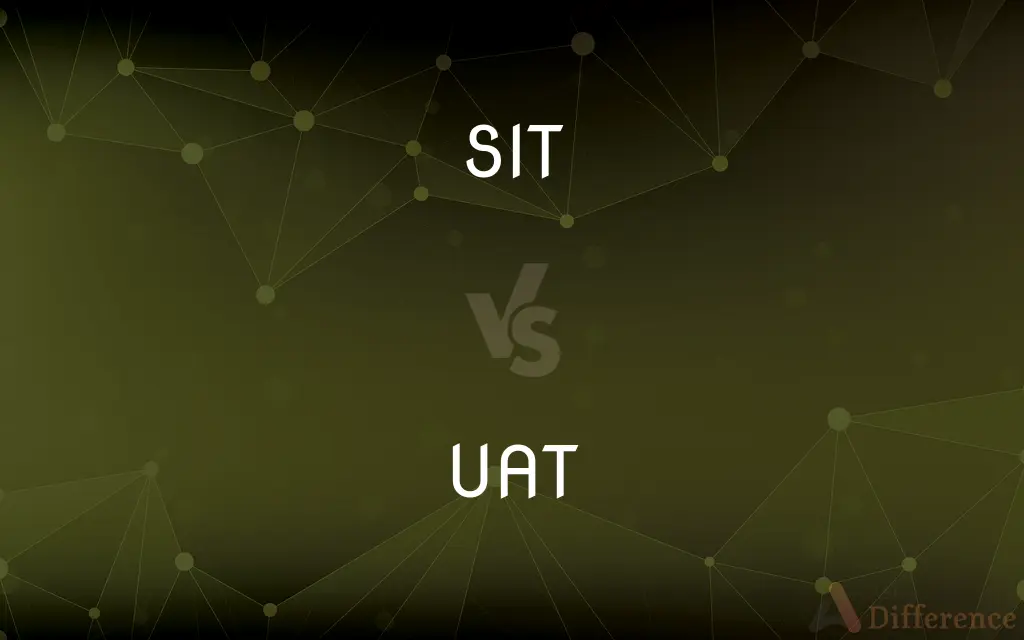SIT vs. UAT — What's the Difference?
By Tayyaba Rehman — Published on January 14, 2024
SIT (System Integration Testing) focuses on testing the integration of different system modules, while UAT (User Acceptance Testing) evaluates the system's functionality and usability from the end-user's perspective.

Difference Between SIT and UAT
Table of Contents
ADVERTISEMENT
Key Differences
SIT involves verifying the interactions between various modules or components of a system to ensure they work together as expected. UAT, on the other hand, is conducted by the end-users to validate if the system meets their needs and requirements.
During SIT, testers focus on technical aspects like data communication, interfaces, and database integration. In UAT, the emphasis is on user experience, ease of use, and whether the software meets the business objectives.
SIT is typically performed by the development team or dedicated QA testers, often before UAT. UAT is conducted by the actual users or clients of the system, usually after SIT is successfully completed.
In SIT, test cases are based on system requirements and architecture. In UAT, scenarios are based on real-world use cases and business processes.
SIT aims to identify technical faults and integration issues. UAT aims to ensure the final product is aligned with the user’s expectations and is ready for deployment.
ADVERTISEMENT
Comparison Chart
Focus
Integration of system components.
Meeting end-user requirements.
Conducted by
QA testers or development team.
End-users or clients.
Test Basis
System requirements and design.
Real-world user scenarios.
Objective
Ensure technical compatibility and functionality.
Confirm usability and fulfillment of business needs.
Stage in Development
Performed before UAT.
Conducted after SIT.
Compare with Definitions
SIT
SIT assesses the interaction between integrated system components.
The team conducted SIT to ensure the new module worked seamlessly with the existing system.
UAT
UAT focuses on meeting the software's business objectives.
The UAT phase allowed users to verify if the software streamlined their workflow as intended.
SIT
SIT identifies problems in system interfaces and data flow.
During SIT, we discovered a data syncing issue between two system modules.
UAT
UAT helps identify any mismatches between user expectations and the final product.
During UAT, users pointed out several usability improvements needed in the software.
SIT
SIT ensures different parts of the software work together.
The SIT phase was essential to confirm the compatibility of the updated database with the application.
UAT
UAT confirms the software’s readiness for real-world application.
The successful completion of UAT marked the software as ready for operational use.
SIT
SIT verifies the complete system's functionality post-integration.
After integrating the payment gateway, SIT was crucial to validate transaction processes.
UAT
UAT involves testing by real users to validate software usability.
In UAT, end-users tested the application to confirm it met their business requirements.
SIT
SIT is an integral part of the software quality assurance process.
SIT helped us ensure that all system components were correctly integrated and functioning.
UAT
UAT is the final testing phase before software deployment.
Before the software release, UAT was conducted to ensure user satisfaction.
Common Curiosities
Who typically performs UAT?
UAT is typically performed by the end-users or clients of the software.
Is SIT done after UAT?
No, SIT is usually done before UAT in the software testing lifecycle.
Is SIT more technical than UAT?
Yes, SIT is more technical, focusing on system internals, unlike UAT, which focuses on user experience.
What happens if a software fails UAT?
If software fails UAT, it is typically sent back for revisions and improvements.
Is user training part of UAT?
Yes, user training can be a part of UAT to ensure users understand the software.
Are automated tests used in SIT?
Yes, automated tests are often used in SIT for efficiency.
Can UAT influence final software changes?
Yes, feedback from UAT can lead to final adjustments before software release.
What is the primary goal of SIT?
The primary goal of SIT is to test the integration and interaction of different system components.
Can SIT be skipped in software development?
Skipping SIT is not recommended as it can lead to undetected integration issues.
What types of tests are included in SIT?
SIT includes interface, data flow, and functionality tests among others.
Are defects found in UAT critical?
Yes, defects found in UAT are critical as they directly impact user satisfaction.
Is documentation reviewed during UAT?
Yes, user documentation is often reviewed during UAT to ensure clarity and accuracy.
Can SIT be outsourced?
Yes, SIT can be outsourced, especially if specialized expertise is required.
Do end-users design test cases for UAT?
Yes, end-users often contribute to designing UAT test cases based on real-world scenarios.
How long does SIT typically take?
The duration of SIT varies depending on the complexity of the system.
Share Your Discovery

Previous Comparison
Vitamin C vs. Ascorbic Acid
Next Comparison
AutoCAD vs. FreeCADAuthor Spotlight
Written by
Tayyaba RehmanTayyaba Rehman is a distinguished writer, currently serving as a primary contributor to askdifference.com. As a researcher in semantics and etymology, Tayyaba's passion for the complexity of languages and their distinctions has found a perfect home on the platform. Tayyaba delves into the intricacies of language, distinguishing between commonly confused words and phrases, thereby providing clarity for readers worldwide.













































